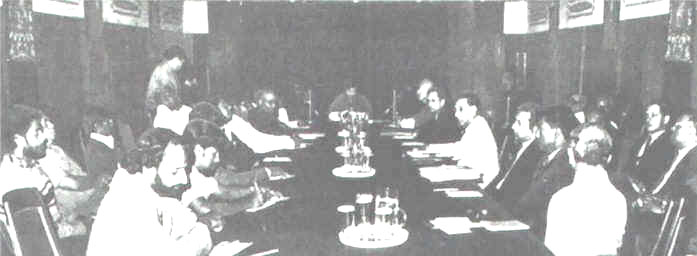
Inside the Meeting Hall - Phase 1 of Talks
Tamil Delegation on Left and Sri Lanka Delegation on Right
|
In June 1985, at the initiative of the Government of India, the leaders of the Tamil militant movements which were engaged in an armed struggle for the establishment of a separate Tamil Eelam state in the North and East of the island of Sri Lanka, agreed to a 'cease-fire' as a preliminary step to creating a 'congenial' atmosphere for 'peace talks'. Phase I of the talks commenced on 8th July 1985 and concluded on 13th July 1985. Phase II of the talks commenced on 12th August 1985 and concluded on 17th August 1985. The venue of the talks was Thimpu, the capital city of the Himalayan kingdom of Bhutan. The Tamil Delegation consisted of representatives from the Liberation Tigers of Tamil Eelam (LTTE), Eelam People's Revolutionary Liberation Front (EPRLF), Tamil Eelam Liberation Organisation (TELO), Eelam Revolutionary Organisation (EROS), Peoples Liberation Organisation of Tamil Eelam PLOTE) and Tamil United Liberation Front (TULF). The LTTE, EPRLF, TELO and EROS were also constituent members of the Eelam National Liberation Front. 
Lawrence Thilagar, LTTE in centre
in front of the Meeting Hall in Bhutan
|
In Phase I of the talks Mr.Anton and Mr. Lawrence Thilagar represented the LTTE. Mr.A.Varadarajah Perumal and Mr.L.Ketheeswaran represented EPRLF. Mr.Charles Antonidas and Mr.Mohan represented TELO. Mr. Rajee Shankar and Mr.E.Ratnasabapathy represented EROS. PLOTE was represented by Mr.Vasudeva and Mr.Dharmalingam.Sitharthan. The TULF delegates were Mr.M.Sivasithamparam, Mr.A.Amirthalingam and Mr.R.Sampanthan. In Phase II there was one change in the composition of the Tamil delegation - Mr.Nadesan Satyendra and Mr.Charles Antonidas represented TELO. The Thimpu negotiations represented a watershed in the Tamil Eelam struggle for more reasons than one. Firstly, the recognition accorded to the armed resistance movement by both the Sri Lankan government and the Indian government and the open participation of the representatives of the armed resistance at negotiations with accredited representatives of the Sri Lankan government, furthered the legitimisation of the armed struggle of the Tamil people in the international arena. Secondly, the Declaration made by the Tamil delegation at Thimpu, which has come to be known as the Thimpu Declaration, and the statement made by Nadesan Satyendra at the Talks on 14 August 1985 and the Joint Response of the Tamil Delegation on 17 August 1985, served to crystallise the central issues of the Tamil struggle and provide a mobilising platform for the continuation of the struggle. |